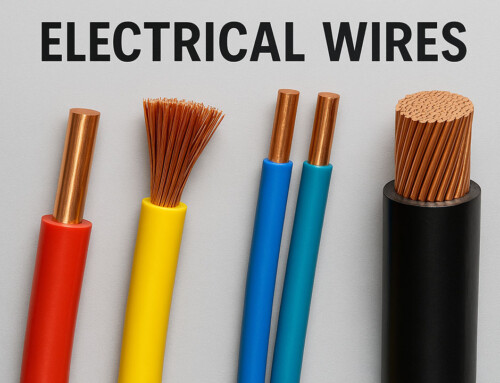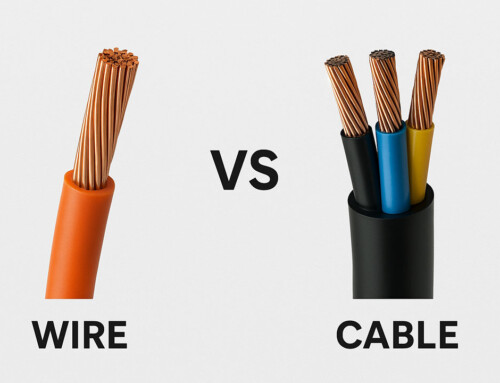Table of Contents
THHN (Thermoplastic High-Heat Resistant, Nylon Coated) is essential for electrical wiring and installations. Whether you are a seasoned electrician, DIY enthusiast, or simply someone curious to understand the nitty-gritty of electrical materials, THHN wire is the perfect way to begin. It’s also known as the building wire and is covered with polyvinyl chloride insulation with a nylon jacket.
In this article, we will explore what THHN wire is, its unique characteristics, where it’s commonly used, and the key benefits it offers.
What is THHN Wire?
THHN wire is a type of electrical wire commonly used in buildings and construction. It’s known for being tough and able to withstand high temperatures. The letters THHN stand for:
T: Thermoplastic
H: Heat-resistant
H: High-temperature
This means the wire is made from a material that can handle high temperatures without melting or getting damaged. It’s often used in places where there’s a lot of heat, like near motors, heaters, or other electrical equipment.
What are the Key Features of THHN Wire?
THHN wire is a versatile wire possessing very unique and specific properties. Here are top key features:
-
Insulation Properties
THHN wire features a dual-layer insulation system consisting of thermoplastic PVC inner insulation and a nylon-out jacket. This combination makes it an apt choice for chemical, oil and moisture resistance.
-
Heat Resistance & Temperature Ratings
THHN wire is designed to withstand high temperatures, commonly rated for 90°C (194°F) in dry locations and 75°C (167°F) in wet locations. This makes it suitable for a wide range of environments and applications.
-
Conductivity and Electrical Performance
THHN wire uses top-notch copper or aluminum to ensure excellent electrical conductivity. It’s designed to minimize energy loss and boost power transmission. This proves that THHN wire perfectly fits residential and industrial electrical systems.
-
Durability and Mechanical Strength
The nylon outer jacket provides additional mechanical strength, enhancing the wire’s durability. It resists abrasion and damage during installation, reducing the likelihood of insulation tears or nicks.
-
Sunlight Resistance
THHN wire is often rated for UV resistance, allowing it to be used in outdoor applications without degradation from sunlight exposure. This feature is handy for wiring outdoor conduits and other exposed environments.
Construction and Components
Here are the essential components that go into building the THHN wire.
-
Conductor – Copper & Aluminium Options
Copper and aluminium are the primary materials used to create electrical conductors. Copper is known for its high electrical performance and durability, while aluminium is lightweight and cost-effective.
-
Insulation – Thermoplastic Elastomer Material (TPE)
TPE is used primarily for insulation as it highlights flexibility and durability. It provides brilliant electrical insulation that protects it from external factors such as weather/temperature fluctuations.
-
Outer Sheath: Flame-Retardant and Moisture-Resistant Jacket
The cable’s outer cover is designed to be flame-resistant and moisture-proof for safety and increased longevity. This protective layer shields the internal components from environmental damage.
Applications and Uses
With all these multitudes of benefits of THHN, let’s now take a peek at the applications and uses of THHN wires.
-
Residential Wiring: Interior and Exterior Circuits
Residential wiring encompasses home electrical circuits, including lighting, outlets, and appliances. It covers exterior elements like garden lighting, security systems, and garages. Proper installation is crucial for safety and efficiency.
-
Commercial Buildings: Power Distribution and Lighting Systems
Commercial buildings require a consistent and robust power distribution system. These buildings will have higher loads and diverse requirements. Hence, it becomes crucial that these buildings’ lighting systems involve emergency lighting, emergency-efficient fixtures, and automated control.
-
Industrial Facilities: Machinery Control, Motor Circuits, and Process Automation
Industrial facilities depend on specialized wiring to control machinery, motor circuits, and automated processes. They demand high durability and reliability to minimize downtime. Advanced control systems often integrate with wiring to optimize operations and enhance safety.
-
Outdoor Installations: Overhead Lines, Conduit Systems, and Junction Boxes
Outdoor electrical installations include overhead power lines, conduit systems, and junction boxes designed to withstand environmental conditions. These installations are critical for delivering power to residential, commercial, and industrial areas. Proper materials and installation techniques ensure longevity and safety.
-
Specific Applications
Specific industries have unique wiring needs, such as marine wiring, aerospace, or medical facilities requiring specialized wiring for safety.
THHN Wire Size Chart
| Copper | Aluminum | ||||
| Wire Gauge Size |
60°C (140°F) NM-B, UF-B |
75°C (167°F) THW, THWN, SE, USE, XHHW |
90°C (194°F) THWN-2, THHN, XHHW-2, USE-2 |
75°C (167°F) THW, THWN, SE, USE, XHHW |
90°C (194°F) XHHW-2, THHN, THWN-2 |
| 14 | 15 | 20 | 25 | – | – |
| 12 | 20 | 25 | 30 | 20 | 25 |
| 10 | 30 | 35 | 40 | 30 | 35 |
| 8 | 40 | 50 | 55 | 40 | 45 |
| 6 | 55 | 65 | 75 | 50 | 55 |
| 4 | 70 | 85 | 95 | 65 | 75 |
| 3 | 85 | 100 | 115 | 75 | 85 |
| 2 | 95 | 115 | 130 | 90 | 100 |
| 1 | – | 130 | 145 | 100 | 115 |
| 1/0 | – | 150 | 170 | 120 | 135 |
| 2/0 | – | 175 | 195 | 135 | 150 |
| 3/0 | – | 200 | 225 | 155 | 175 |
| 4/0 | – | 230 | 260 | 180 | 205 |
| 250 | – | 255 | 290 | 205 | 230 |
| 300 | 285 | 320 | 230 | 260 | |
| 350 | – | 310 | 350 | 250 | 280 |
| 500 | – | 380 | 430 | 310 | 350 |
| 600 | – | 420 | 475 | 340 | 385 |
| 750 | – | 475 | 535 | 385 | 435 |
| 1000 | – | 545 | 615 | 445 | 500 |
Advantages / Benefits of THHN Wire
The advantages and benefits of THHN Wire are
- Flexibility: THHN wire is designed to be highly flexible, making it easy to install in tight spaces and around corners.
- Durability: The wire is built to fight harsh environments, providing long-lasting performance and avoiding wear and tear.
- Heat Resistant: THHN wire can resist high temperatures, typically up to 90°C (194°F) in dry locations. This makes it suitable for applications where heat is a significant concern.
- Chemical Resistance: The THHN’s insulation is resistant to various chemicals and oils. This makes it ideal for use in industrial environments where exposure to such elements is expected.
Limitations of THHN Wire
There are certain limitations to the use of THHN wire.
- If the temperature goes beyond a certain Fahrenheit, then it can cause damage to the wire.
- Even after being moisture resistant, THHN wire might not be ideal for underground applications.
- In comparison to other cables, THHN is expensive and might not fit everyone’s budget.
What are the alternatives to THHN wire?
Here are our top handpicked alternatives to THHN wires.
- THWN: Thermoplastic High Water-resistant Nylon-coated is thicker, making it suitable for outdoor or humid environments.
- XHHW: High Heat-Resistant, water-resistant (XHHW) offers a higher temperature rating and is more resistant to moisture and chemicals. It’s often used in industrial and commercial settings.
- Romex: It is a cable that bundles THHN wires with a PVC cover, making installation easier.
- MTW (Machine Tool Wire): It’s explicitly designed for flexible and durable applications—for instance, industrial machinery.
- TFFN (Thin Film Heat Resistant Wire): TFFN wire offers excellent heat resistance but may have a lower voltage rating.
- TFN (Thin-Film Non-Halogenated Wire): is similar to TFFN but with non-halogenated insulation, making it more environmentally friendly.
Final Thoughts
D&F Liquidators offers long-lasting and cost-effective THHN wire solutions that are perfect for any project. Our specialized team minimizes waste and provides the best solutions to customers. If you are unsure about the wires you need, contact us; our technicians would be more than happy to help you. Contact us today!
Frequently Asked Questions
What is THHN wire suitable for?
THHN is a suitable wire applicable for a wide range of electrical applications. Its heat-resistant and protected insulation makes it ideal for dry and humid environments.
What is the difference between AWG and THHN wire?
AWG (American Wire Gauge) is a standard system for measuring the diameter of electrical wires. THHN (Thermoplastic Heat Resistant Nylon) is a type of wire insulation that provides heat resistance and protection from moisture.
What does THHN wire stand for?
THHN stands for Thermoplastic High Heat-resistant Nylon-coated.
What is THHN copper wire?
THNN copper wire is a type of building wire used for general-purpose wiring. It’s made of nylon insulated with polyvinyl chloride (PVC).
What is the difference between THHN and THWN wire?
The difference is that THHN uses nylon insulation, while THWN utilizes water-resistant nylon insulation.






